NAZIS FORCE BULGE IN ALLIED LINES IN BELGIUM
SHAEF HQ, France · December 16, 1944
“It is essential to deprive the enemy of his belief that victory is certain,” Adolf Hitler told his generals on December 12, 1944. Four days later, on this date in 1944, elements of four German armies, comprising nearly 300,000 German troops in 14 infantry and 5 panzer divisions, smashed through the Ardennes Forest in bitterly cold Belgium and Luxembourg, their massive counterattack trapping thousands of surprised and stunned American soldiers in what became known as the Battle of the Bulge, or the Ardennes Offensive. (See map below.) A simultaneous campaign by the Luftwaffe was to have kicked off on the same date, but it was repeatedly delayed due to bad flying weather until New Year’s Day 1945, when improved weather permitted the start of German air operations. The key to the German ground advance in the northern sector were “Rollbahns” that lined up with the Allied-held Belgian supply port of Antwerp. Never able to open these land routes, the Germans failed to achieve their objectives of retaking Antwerp, driving a wedge between the American and British armies, and forcing a negotiated peace in the west. To the south, in the center of the bulge, the Germans had more success capturing the key Belgian-German road and railroad node in St. Vith, evacuated as a liability now by Americans on December 21–22 after suffering over 12,500 casualties. They failed, however, to take the key town of Bastogne (population 3,500) southwest of St. Vith. Maj. Gen. Anthony McAuliffe, acting commander of the trapped 101st Airborne Division (“Screaming Eagles”) at Bastogne, vital junction of seven hard-top roads, famously replied “Nuts!” to the German surrender ultimatum lest his men face annihilation by an overwhelming number of German troops and tanks. (The German commander was informed that “in plain English” the expression “nuts” meant “Go to hell!”) Elements of Gen. George S. Patton’s Third Army, driving northward, relieved Bastogne on December 26. The Ardennes Offensive came to a complete halt in early January 1945. It was the bloodiest of the battles U.S. forces experienced in World War II, one in which nearly 76,000 Americans were killed, maimed, captured, or went missing. German casualties were put at 84,834, but other estimates range between 60,000 and 100,000. The net effect of the month-long German gamble in the west was to delay the Allied conquest of Germany by just six weeks.
[amazon_carousel widget_type=”ASINList” width=”600″ height=”200″ title=”Recommended Reading” market_place=”US” shuffle_products=”False” show_border=”False” asin=”0306814404,0306813912,1610010159,0803294379,0688151574,0451225589,1853673544,0811734560,0440236274,159416150X” /]
Opening Salvo in the Battle of the Bulge, December 1944
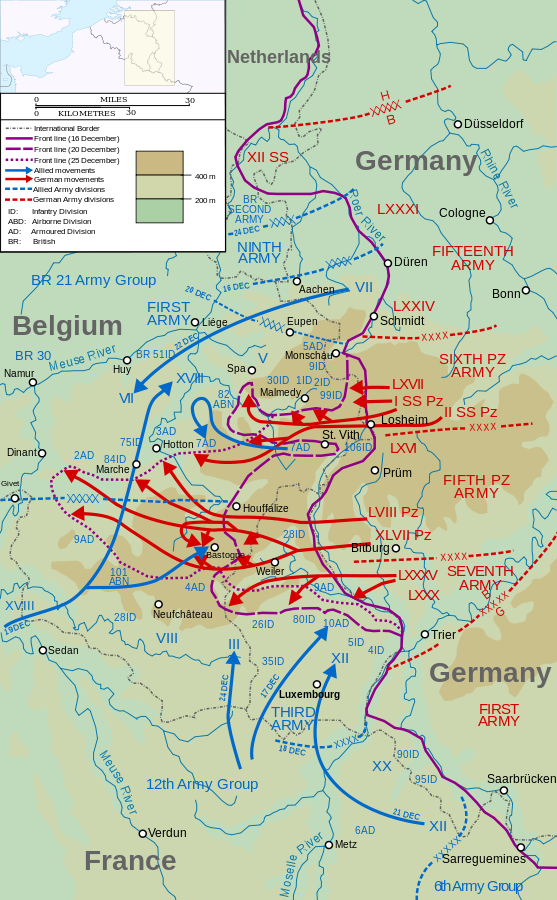 |
Above: Battle of the Bulge (Ardennes Offensive), known by the Germans as Unternehmen Wacht am Rhein (“Operation Watch on the Rhine”). The Germans were counting on the Ardennes Offensive turning the tide of war in the West. The map shows Germans swelling “the Bulge,” as Prime Minister Winston Churchill famously dubbed the German salient (red arrows, purple lines), between December 16 and December 26, 1944. The Allies crushed the Bulge in January 1945.
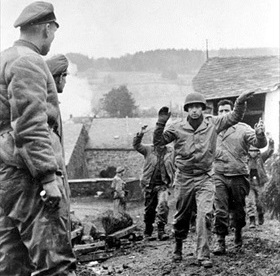 | 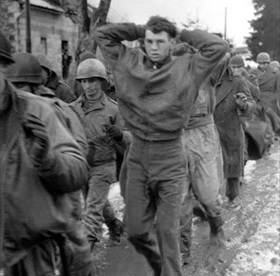 |
Left: As many as 44 soldiers of the 3rd Battalion, U.S. 119th Infantry Division were taken prisoner by members of the German 6th Panzer Army Kampfgruppe (battle group) Peiper in Stoumont, Eastern Belgium, on December 19, 1944. The black-garbed men of Kampfgruppe Peiper soon earned a murderous reputation among GIs, particularly for the horrific massacre of 84 (out of 114) disarmed U.S. artillerymen, infantrymen, medical personnel, and military police in a frozen field outside Malmedy, Belgium. (Lt. Col. Joachim Peiper’s men continued firing machine-gun and pistol rounds into the bodies of the fallen men as their armored convoy of 600 vehicles passed the scene of execution.) Stiffened American resistance forced Peiper’s men to abandon their equipment and trek eastward on December 24 through deep Belgian snow for safety behind German lines. Of Peiper’s 5,000 men at the start of the Ardennes Offensive, only about 800 survived.
![]()
Right: On December 17, 1944, Kampfgruppe Peiper reached an American fuel dump in Buellingen, Belgium, where 200 U.S. soldiers were taken prisoner and forced to refuel Peiper’s tanks. This German photograph may show some of the men from the Second Infantry Division being marched back to German lines, where they were locked in POW cages. Seventeen of their comrades in the small Belgian village of Honsfeld (now part of Buellingen) were literally caught napping. From their sleeping quarters they were hustled outside in their boxer shorts and shot dead, with the exception of one GI who was thrown under the treads of a tank. Overall casualties suffered by the 610,000 American troops (strength as of December 22/23, 1944) who fought during the Battle of the Bulge (December 16, 1944, to January 25, 1945), numbered 75,842, including 8,407 killed, 46,170 wounded, and nearly 21,000 captured. Equipment losses included some 730 tanks and tank destroyers. British losses totaled 1,408, including 200 dead. Estimates of losses for the Germans ranged as high as 100,000, including at least 11,000 killed. Germans also lost 600 irreplaceable tanks and assault guns.
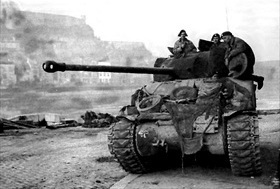 | 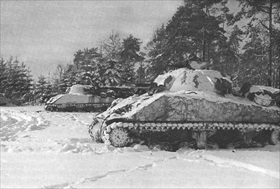 |
Left: During the Battle of Bulge, the British 29th Armoured Brigade formed part of the defensive line on the Meuse River, the center of one of three German attack routes to the west. Tanks of the 3rd Royal Tank Regiment met the vanguard of the German push to the river before the German panzers were turned back. This photo shows a British Sherman “Firefly” tank in the southern Belgian town of Namur on the Meuse River, December 1944. The Firefly was a British variant of the American M4 Sherman tank and was fitted with the powerful British 17‑pounder (3‑in) anti-tank gun as its main weapon. It was highly valued as the only British tank capable of defeating German Panther and Tiger tanks.
![]()
Right: M4 Sherman tanks of the U.S. 7th Armored Division in temporary defensive positions near St. Vith, Belgium, a critical road and rail center needed by the Germans to supply their Ardennes Offensive. The 7th Armored Division was transferred to U.S. First Army, under command of Gen. Omar Bradley, and ordered to St. Vith. Over the course of almost a week, the 7th and elements of other divisions absorbed much of the weight of the German drive, throwing the German timetable into great disarray, before being forced to fall back to entrenched positions to the west on December 23, 1944.
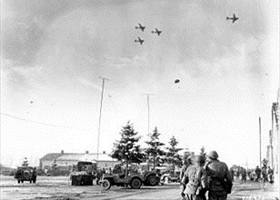 |  |
Left: Troops of the 101st Airborne Division watch C‑47 Skytrains drop supplies to them in the small southeast Belgian road hub of Bastogne, December 26, 1944, ringed by a mass of German troops and tanks intent on reaching the Meuse River. On the ground Gen. George Patton’s Third Army disengaged from its own offensive in the German Saar region and wheeled north toward Bastogne. The 4th Armored Division, Patton’s spearhead, made contact with the 101st Airborne on the same day as the airdrop. The relief of Bastogne and the prolonged action in and around St. Vith and elsewhere dealt a major setback to the German advance, almost halted now by a lack of supplies. Soon the great bulge began to resemble a gigantic Allied pincer rather than a great German threat. As the year ended, so did Hitler’s dream of ultimate victory in the West.
![]()
Right: Mardasson Memorial near Bastogne, Belgium, honors the memory of American soldiers who were killed, wounded, or went missing during the Battle of the Bulge.
Bastogne and the Heroic Stand of the 101st Airborne Division
![]()

 History buffs, there is good news! The Daily Chronicles of World War II is now available as an ebook for $4.99 on Amazon.com. Containing a year’s worth of dated entries from this website, the ebook brings the story of this tumultuous era to life in a compelling, authoritative, and succinct manner. Featuring inventive navigation aids, the ebook enables readers to instantly move forward or backward by month and date to different dated entries. Simple and elegant! Click
History buffs, there is good news! The Daily Chronicles of World War II is now available as an ebook for $4.99 on Amazon.com. Containing a year’s worth of dated entries from this website, the ebook brings the story of this tumultuous era to life in a compelling, authoritative, and succinct manner. Featuring inventive navigation aids, the ebook enables readers to instantly move forward or backward by month and date to different dated entries. Simple and elegant! Click 











